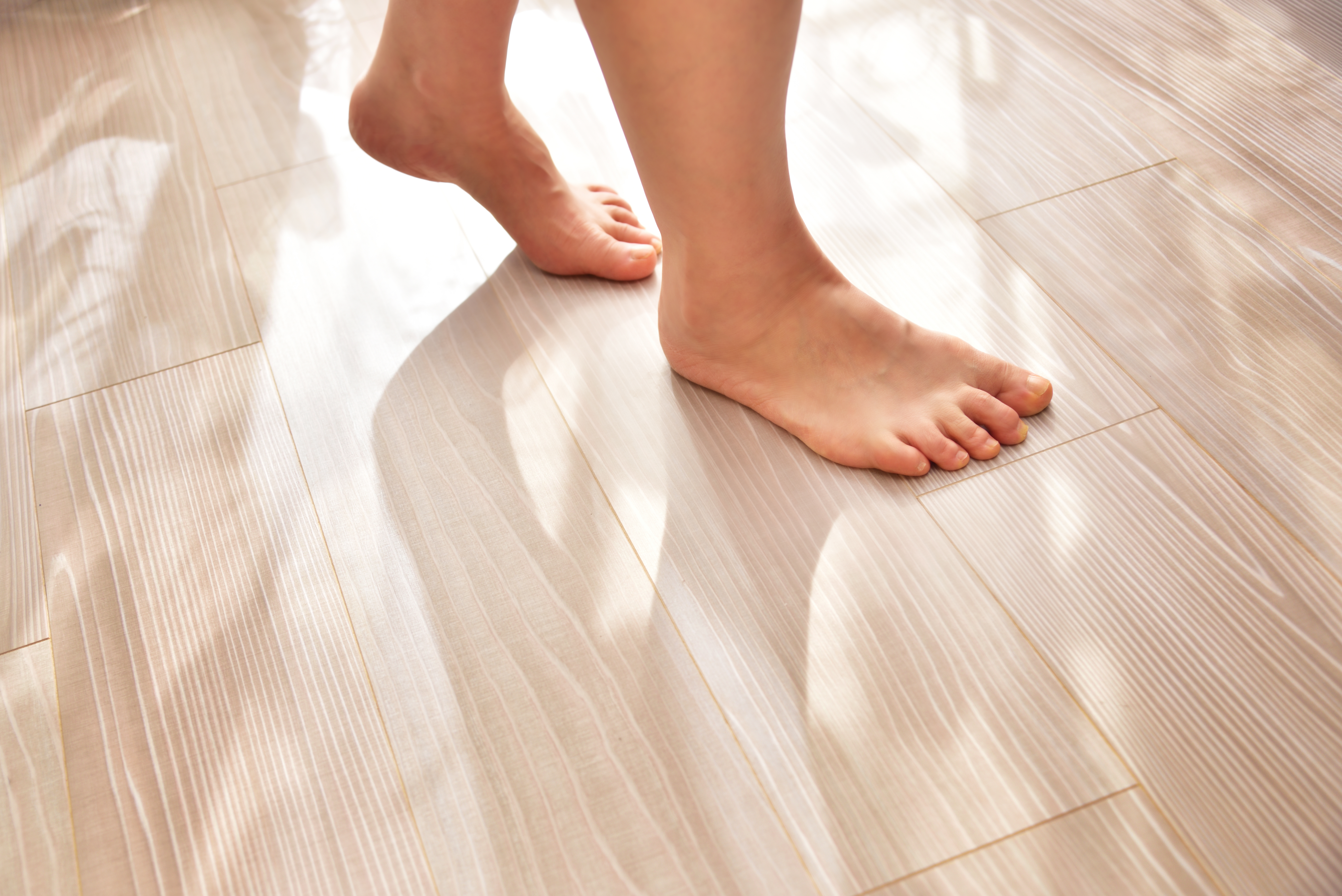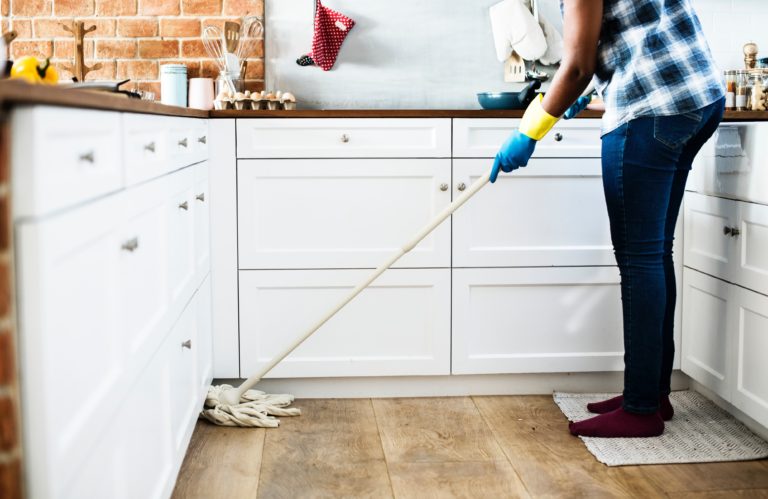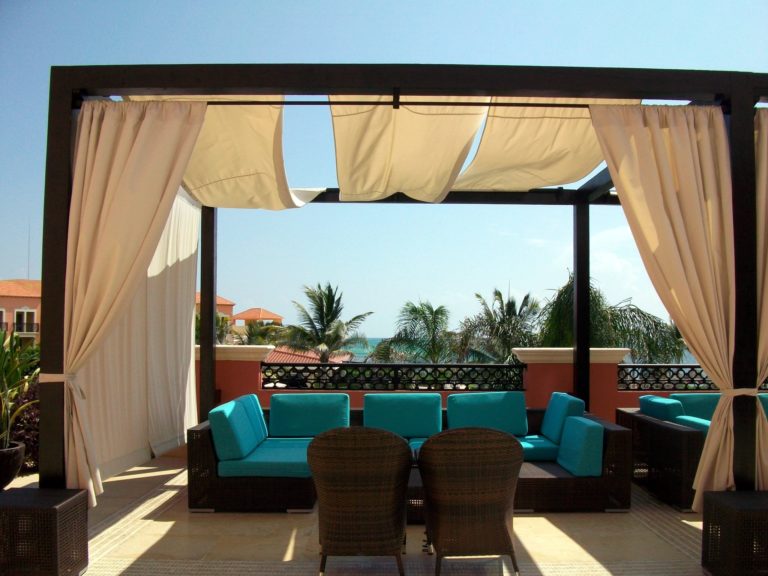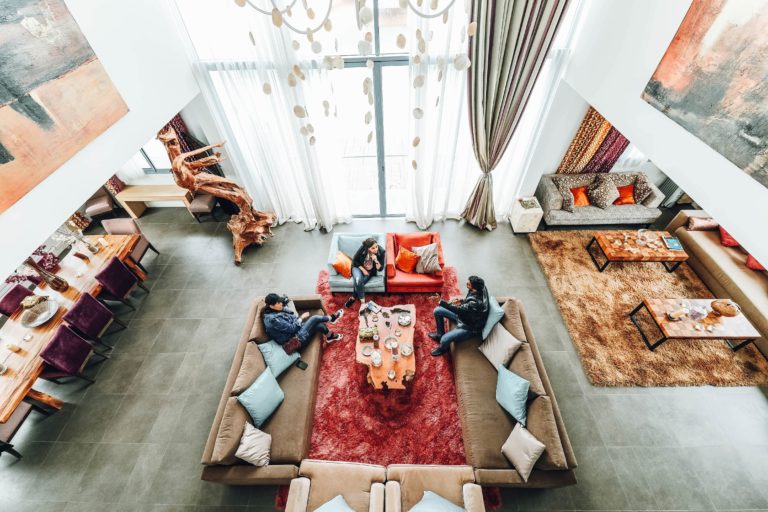This post may contain references or links to products from one or more partners of our parent company and/or subsidiaries of our parent company. For more information, visit this page.
June 16, 2023
Love the look of light wood floors? We don’t blame you! Light-colored wood floors are sleek, easy to maintain, and can give some extra *oomph* to just about any room.
But we know: hardwood isn’t always the easiest flooring to install, and it comes at a relatively high price point. So before you buy, you want to make sure light wood floors are the ones for you.
Don’t worry, friend—we’re here to help! In this article, we’re going to give you all the info you need to choose the perfect floors for you.
We’ll show you how light wood flooring can affect a room, the many benefits of lighter wood flooring vs. darker wood flooring, and the best ways to get that light hardwood look in the first place.
Finally, we’ll take a moment to show you how to get the beauty of light wood floors, without actually using any wood!
If you simply want to know the best brands with the largest variety of light wood flooring options, we recommend looking into Paradiso, Doma and Proximity Mills.
Who’s excited to talk about some light wood flooring? (Hands raised!)
Light Hardwood Floors: An Overview
You don’t need to be Sherlock Holmes to notice that there are endless types of wood flooring on the market. And we’re not just talking about different species of hardwood—but also a variety of colors and finishes, too. Wood flooring can run the gamut from practically black to almost pure white.
When we talk about light wood floors, we’re generally talking about shades that are known in the industry as “blonde”. These floors have very pale or golden undertones.
How Do Light (or Blonde) Woods Affect a Space?
You can achieve many different looks just by altering the color of your floor. Think of your flooring as a canvas—how you build upon it can determine the final look of your space.
Light Wood Floors Can Make a Space Brighter
If your space is naturally bright, light wood flooring is a great way to play into that natural luster. Light wood floors are excellent for sunroom flooring, for example. It feels like a natural extension of the sun, just begging people to come and luxuriate in its warmth. A dark floor, on the other hand, may wind up giving the space a colder feel.
And They Can Give Some Pep to Normally Darker Rooms
If you have a room that doesn’t get much natural sunlight, it may need help to prevent it from feeling gloomy. Many bedrooms, for example, aren’t built with sun-facing windows (which are often reserved for larger family rooms and kitchens).
So: if you’re debating between carpet or hardwood in your bedroom, it might very well be worth installing a light wood floor!
Blonde Wood Can Also Make a Space Appear Larger
Light wood floors are fantastic for creating the illusion of more open space. Think about the words used to describe light-colored rooms: airy, open, and natural. Not only does lighter wood flooring fool the eye into thinking there’s more space than is really there, but any natural sunlight will reflect off the floor, too—further adding to the illusion of space!
Just remember: the appearance of space within a room also depends on whether the color of your floor is solid or striated, and how visible the grain is. Plus, wood floor patterns can make a huge difference in creating looks and styles.
Best Brands of 2024
The Benefits of Light Wood Floors vs. Dark Wood Floors
Light wood floors don’t just make spaces appear brighter and larger—they also have a number of other advantages over darker wood floors.
Light Hardwood Flooring is Easier to Keep Clean
Want to hear something counterintuitive? Dirt is super easy to notice on dark hardwood floors. It doesn’t blend in as well as you’d probably think. Dust, hair, and crumbs are typically pretty light, so they’re much more likely to contrast with the dark background. Light hardwood floors do a better job of hiding your dirt!
That’s not to say that you can give up on cleaning your floors, but you may cringe a little less when unexpected guests drop by.
Light Hardwood Flooring Doesn’t Show Scratches as Easily
Of course, your hardwood floor isn’t going to be impervious to scratches. Even the most durable wood flooring can get dinged up now and again. And the damage will probably stand out more on darker hardwood.
This is because most dark hardwood flooring is stained a darker color, so the natural wood underneath is a lighter shade than what you see on top. When the stain layer gets scratched or dented, it creates a sharp contrast.
A light hardwood floor, on the other hand, won’t have that deep contrast. Scratches won’t stand out as much because the top layer mostly matches what’s underneath. If you don’t have super scratch-resistant flooring but you do have kids or pets, light wood may be the way to go.
Light Hardwood Flooring is Better for Dog Owners
As any dog owner will tell you, our four-legged friends can be a bit messy (and occasionally destructive). If visible scratches stress you out, light hardwood is an excellent option to consider. It is among the best wood flooring for dogs, since it hides scratches pretty well. And dogs are going to scratch.
The ability to hide dirt, grime, and scratches a bit better than dark hardwood makes light hardwood floors good for homes with kids and high traffic areas, too. Consider replacing those allergen-magnets known as “carpets” with light hardwood. It’s easier to clean, too! Maybe some nice parquet flooring in the entry hall?
Light Hardwood Floors Can Make Your Space Look Brighter and Larger
We know we mentioned this before, but we have to say it again. Lighter-colored floors reflect light, making rooms appear brighter and larger.
Dark hardwood, on the other hand, absorbs light. This has the opposite effect, making rooms feel closer and darker. In some rooms, this is an advantage! In others, not so much.
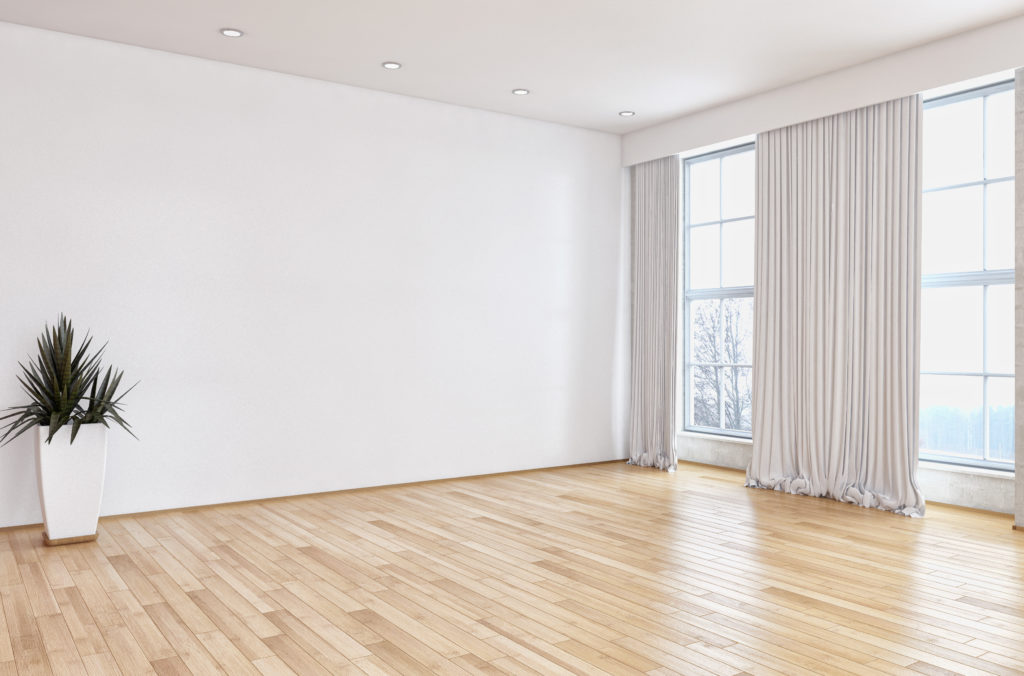
Light Wood Flooring vs. Dark Wood Flooring: Other Things to Consider
Are you unsure whether you prefer light wood floors or dark wood floors? Can’t decide between the two? We get it—it’s possible to love both blonde hardwood and ebony flooring at the same time!
Here are some other things to consider when making your decision.
Darker Wood Stains Hide Imperfections
Light hardwood may hide dings and grime, but it can’t hide imperfections in the wood as well as dark hardwood can. If your wood has lots of knots or water stains, it might be better off with a dark stain.
Which Costs More: Dark or Light Wood Floors?
The answer to this really depends on whether you’re finishing the planks on-site or purchasing prefinished hardwood flooring.
If you’re buying a hardwood floor that’s prefinished, the cost is generally going to be the same for either shade. What will affect the pricing most is the type of wood you are buying, not the color. For example, teak flooring is always going to be more than your standard oak floor because it’s a luxury item.
If you’re finishing your floors on-site, darker stains generally cost a bit more—you may need multiple coats of stain, and an extra layer of sealant to protect it. Of course, the price difference isn’t going to be massive but it is something to keep in mind if you’re nervous about the cost to replace carpet with hardwood or some such.
Which Offers a Higher Resale Value: Light Wood Flooring or Dark Wood Flooring?
The individual home and the individual buyer will play the biggest roles in determining which color floor sells better.
The cost to refinish hardwood flooring might be a tad lower for light wood flooring (for the reasons above), but really, the differences are pretty negligible. At the end of the day, the best hardwood floors are the ones that you like the most!
How to Choose Light Hardwood Floors
There’s a lot to take into consideration when picking out new flooring—your personal taste, the layout of your home, how much traffic the floors will see, etc.
It may feel like an overwhelming decision, but it’s manageable if you break it down into smaller pieces. Consider different aspects of your home, one at a time, as you’re making your choice. There’s no need to rush.
Light Wood Flooring in the Living Room
Since families tend to spend most of their time together in the living room, it’s best to keep this area simple. If you’re going the light wood flooring route, natural looks are ideal. Families tend to be busy; the living room floor doesn’t need to feel busy, too.
Opt for a hardwood that doesn’t have a lot of grain or variation in color. Again, simple is the magic word. With little variation, you can make a big statement.
Light Hardwood Floors and Dark Furniture
The color contrast between your floor and furniture can be striking. The key to making sure they don’t just clash is ensuring that the furniture and the floor have similar undertones. This is easier than trying to match all the wood, which would be near impossible.
Which Light Hardwood Floor Goes Best with Your Kitchen Cabinets?
If you have the white kitchen cabinets so common in contemporary designs, almost any floor color will look good. If you have darker cabinets in your kitchen, aim to create a contrast between them and your flooring. The lighter your cabinets are, the warmer the tones your floor should be. Beware of red tones, though—they don’t mix well with other reds!
Just remember: if you do decide to put wood in your kitchen, make sure it’s some type of water-resistant wood flooring. Even simple engineered wood is better than solid when it comes to this application!
Engineered wood disadvantages aside (and there aren’t too many of them) it’s the next best thing to PVC flooring for the occasional spill. And remember: all vinyl flooring is waterproof vinyl flooring, so engineered vinyl plank (aka EVP flooring) is always a great option if you’re an active home chef.
Lighter Wide Plank Wood Flooring
Wide plank wood flooring is very “in” right now. And we absolutely love lighter-colored wide plank floors. Just remember: if you go with a wide-plank option that has a lot of knots in it, it might start to look like cabin flooring. That’s a pro for some people, but a con for others. Either way, it is something to keep in mind!
It’s also worth noting that you won’t find many wide plank wood floors made out of solid hardwood. Softwoods like pine, yes—but wide plank hardwoods like oak are almost always engineered wood flooring (because it’s less prone to warping).
How to Get Light Hardwood Flooring
There are three important components that go into getting the light look you crave. And we don’t just mean bleaching wooden floors (though that is totally a thing!)
The shade of your wood floor depends on:
- The hardwood species
- The stain
- The finish (hardwax, shellac, hardening oils like tung or walnut, etc.)
Each one of these components will affect the color of the wood, and by altering any of the three, you can completely change the shade of your floor. The combinations are practically endless!
The Best Wood Species for Light Wood Flooring
While stain and finish affect a floor’s color, they don’t affect it nearly as much as the wood’s species. Here are some of the most common ones.
PS: all of the best engineered wood flooring options can be purchased in any one of these species, so don’t be afraid to move away from solid wood! The best engineered wood flooring brands offer reliable, durable, and oh-so-pretty high-performance floors.
Maple
Maple is the lightest common hardwood flooring species of all. Its smooth grain and modern look make it a great choice for very light wood floors. Pro tip: If hardness is an important factor for you, steer away from southern maple species, as they tend to be softer.
Hickory
Hickory is a very strong and durable wood. It’s excellent if you like a rustic look, as it comes with a lot of character and heavy grain.
Hickory planks have tons of contrasting colors, and they look great natural or stained. It also holds a stains very well, making it easier to refinish.
Color aside, there are some hickory flooring pros and cons to consider when installing this hardwood in your home. If you’re looking for do-it-yourself flooring, move along—hickory is famously hard, which is great for flooring… but not for installing that flooring.
Oak
Oak is a very plentiful wood and incredibly common for floors (in fact, it’s the industry standard). And lucky for us, we get to choose between red oak and white oak!
Red oak is very light and has pink tinges, with a very visible grain. White oak, on the other hand, is surprisingly a bit darker—it has more of a golden tint to it, and it’s a tiny bit harder.
Oak is similar to hickory in many ways, so it is worth looking into the advantages and disadvantages of hickory vs. oak flooring if you’re curious.
Ash
Ash flooring is another wood that’s a lot like oak. It’s a little less hard, though, and has a very strong grain. In fact, you can use this grain can create some very beautiful and interesting wood floor designs.
Want a way to get affordable ash flooring? Look into engineered hardwood. If you’re wondering what is engineered hardwood, it’s just a solid wood veneer bonded to a high-performance plywood core. Since you aren’t paying for a full-thickness plank of wood, the cost to install engineered hardwood is usually lower than it is for solid.
Saving money and saving resources? Big thumbs up.
Pine
Pine flooring is another beautiful choice for light wood flooring. It’s a long-lasting floor that will serve you well in the right setting. However, it is a softwood, so it is more susceptible to scratches and dents. It may not be appropriate for all places in your home, but if you find the right room for it, it will last for years.
Pine is also a very abundant wood, so you don’t need to worry about availability. You can easily find pine anywhere in the world. And because it’s such a sustainable wood flooring type, it’s also easy on the wallet!
Douglas Fir
Douglas fir flooring isn’t the same as pine flooring—but it’s close! Douglas fir is similar to pine in many respects; it’s a softwood, it’s light, and it’s sustainable. And most importantly, they both make beautiful light wood floors!
How Finish Impacts the Color of Light Hardwood Flooring
Wood is a natural product, so sunlight can ultimately change the color of your wood flooring. Some finishing products can slow that phenomenon. You could apply a finish with a UV inhibitor, since UV light is one of the components of sunlight that does the most damage.
Looking for an eco-friendly finish for your light wood flooring? Consider shellac. It’s a natural, sustainable product that will seal and finish your flooring with few to no VOCs (volatile organic compounds), which are quite common but can have harmful health effects. If you are concerned about these chemicals in your home be sure to check out some low-VOC flooring options.
Which Hardwood Floor Stain Colors are Most in Style?
Whitewash stain is a very traditional approach to light wood flooring that’s coming back into vogue. Its cool tones create a very airy and open aesthetic. Whitewash can go a long way towards brightening a home, though it can be a bit more pricey than your average stain.
Just remember: whitewash doesn’t work well on wood that has golden or red undertones, nor on darker species of wood.
Light grey is another contemporary look, and a somewhat tweaked version of whitewash. This stain mixes white with ebony to create a shade that can vary from light to dark, depending on the ratio of each color. The effect can be striking, making your floor lighter overall.
Light Hardwood Flooring FAQ
What’s not to love about light hardwood floors? They’re stylish, easy to maintain, and look crisp. The feeling of airiness they create is hard to capture.
Are Light Hardwood Floors in Style?
Right now, both dark and light hardwoods are on-trend. Light wood floors are super popular thanks to the inviting feeling the cool tones create. They are bright, modern, and cheery. The natural look is always in style, and light hardwood floors are one of the easiest ways to get that aesthetic.
What is the Best Wood Floor Color?
Nobody can really tell you what the best wood floor colors are for your home. The choice depends on many different factors, including the size of your space, what it’s used for, and your own design goals.
More importantly, it really depends on YOU. What color do you like?
Should Floors be Darker or Lighter than Walls?
Here’s another question that has no definitive answer. In general, darker floors and lighter walls help to create a sense of order for the eye.
However, a light floor and darker walls can be pulled off if done correctly. Be sure that the undertones of the walls and the floor match, and you’ll be ok!
Do Light Hardwood Floors Go with Grey Walls?
In case you’ve been hiding in a cave for the past few years, allow us to clue you in: grey walls are hot right now. They’re very contemporary. The only catch is that they can feel a little cold.
You might be tempted to think that light hardwood floors with grey walls would only increase this cold feeling. Not so! Pairing them with some white trim and a light golden floor warms up a space.
Which Hardwood Species has the Lightest Color?
Most wood flooring can be refinished and stained lighter, so there is some flexibility in the type of wood used. If you’re looking for a natural, unfinished hardwood floor that’s also very light, the hardwood species you choose will be very important. Don’t worry—all the best hardwood floor brands offer an endless array of light options.
Naturally light species such as red or white oak, maple, birch, or ash can all be excellent choices for natural wood.
Light Wood Flooring Alternatives
Love the look of light wood but don’t think hardwood is the best fit for your space? Check out these hardwood floor alternatives. Seriously—fake wood flooring is gorgeous these days, and it can go many places where hardwood isn’t suitable.
Bamboo
Bamboo isn’t wood at all—it’s actually part of the grass family! But if you think that makes it flimsy, surprise surprise: the best bamboo flooring has a crazy high hardness rating. In fact, if you compare bamboo flooring vs. laminate (a super hard floor), you’ll find they’re similarly durable.
Bamboo flooring is fairly light to begin with. And even better: you can refinish bamboo flooring just like hardwood to give it any color you want. In fact, we’d recommend checking out some engineered bamboo flooring pros and cons for that exact reason.
Cork
Wait… did we just say “cork”? Yup, we sure did!
The best cork flooring isn’t just gorgeous—it’s also durable, comfortable, and antimicrobial. It’s very sustainable, too—and eco-friendly flooring is always a major plus in our book!
Of course, there are a few disadvantages of cork flooring, such as its tendency to get dings fairly easily. But (back in the win column) it can usually be refinished.
Either way, we’d recommend looking into the pros and cons of cork flooring—it can offer an excellent light wood floor alternative with some surprising perks!
Luxury Vinyl Plank (aka LVP or LVT)
LVP is one of the most popular types of flooring on the market, and it’s easy to see why. It’s waterproof, it’s incredibly durable, and it’s beautiful. In fact, some of the best vinyl plank flooring brands are virtually impossible to distinguish from actual wood flooring types.
Plus, innovations in core construction have made LVP variants like WPC flooring incredibly comfortable to walk on—rivaling even the best laminate flooring (the other most popular type of faux wood flooring) in appearance and underfoot feel. And installation styles are endless. You can find glue-down vinyl plank flooring, loose lay vinyl plank flooring, outdoor vinyl flooring… the list goes on.
All of that to say: there aren’t many disadvantages of vinyl plank flooring—it’s even budget-friendly, and the cost to install vinyl plank flooring is lower than it is for wood. The biggest downside: it’s not terribly eco-friendly, so you’re going to want to exclusively look for low-VOC vinyl flooring options.
In any case, if you want the look of light wood floors without any of the actual issues that come with having light wood floors, vinyl plank is a great substitute.
Laminate
What is laminate flooring? It’s a wood-look floor that consists of fiberboard, topped with a super-realistic image of wood grain, and finished with a protective wear layer.
It’s a very durable floor that mimics hardwood while doing things that real wood can’t do. For example, RevWood, a type of laminate, is completely waterproof. Translation: you can finally have that wood floor bathroom or hardwood mudroom flooring you’ve always wanted!
There’s a lot to consider when debating laminate vs. hardwood floors, or even vinyl plank vs. laminate. But at the end of the day, you can get all of them in the light wood flooring look you want.
Concrete Flooring That Looks Like Wood
Believe it or not, there really is such a thing as concrete flooring that looks like wood. And it’s amazing!
As you would imagine, concrete can be used in ways you can’t use hardwood—as an outdoor flooring option, for instance. But to be able to make it look like hardwood flooring is revolutionary. Think of all the possibilities!
One more bonus? Concrete flooring doesn’t use any unsustainable products, so it’s a surprisingly environmentally friendly flooring choice.
Wood-Look Tile
Depending on where you’re putting new flooring, you may want to consider the pros and cons of tile vs. wood floors. Tile is another product that can mimic the beautiful look of light wood floors.
Wood-look tile is generally ceramic, which is just one of many different types of tile on the market.
And contrary to popular belief, it doesn’t have to be difficult to install, either. Snap-together tile flooring, for example, can make installation easier (and less messy) than you imagine. And going with tile may be the cheaper option when you consider the overall wood flooring costs you may be dealing with.
Conclusion
An airy, bright space is just so cheerful—and couldn’t we all use a little cheer in our lives?
Of course, not everyone has the same tastes, and light wood floors simply may not be your jam. And that’s ok! But if you’re like us, you know that light wood flooring is absolutely gorgeous.
So if you think you’re ready to look at some samples, find a flooring store near you for some professional help. And whatever you choose, good luck finding your perfect floors!
For more information on all things flooring, check out:
- Non-Toxic Laminate Flooring 101
- A Guide to Peel-and-Stick Carpet Tiles (& 9 Reasons They’re Amazing)
- Click-Together Flooring: Your Questions Answered
- Carpet vs. Laminate: The *Real* Pros & Cons
- What is Subflooring? Underlayment? We’ll Explain.
- Heating Wood Floors 101: Everything You Need to Know
- LifeProof Vinyl Flooring Reviews: Is It Worth It?
- Hemp Flooring: Your Complete Guide to Hemp Wood
- Tile vs. Laminate Flooring: The Pros and Cons
- What is a Floating Floor: The Basics
- Magnetic Flooring: Everything You Need to Know
- SmartCore Flooring Reviews: Is it Worth it?
- Engineered Hardwood vs. Laminate: Side-by-Side Comparison
- Stainmaster Luxury Vinyl Reviews: Is it Worth It?
- COREtec Flooring Reviews: Plus, Pro Plus, & More
- How to Install Carpet Tiles in 7 Easy Steps
About The Author

Courtney Daily
April 28, 2021
Courtney is a freelance writer who wears many other hats: kindergarten teacher by day, Broadway diva in the shower. She is a transplant Hoosier who originated in New England. When she isn't writing in her spare time, you will find her reading history books, arguing with her latest knitting project, or being beaten by her kids at most games.
